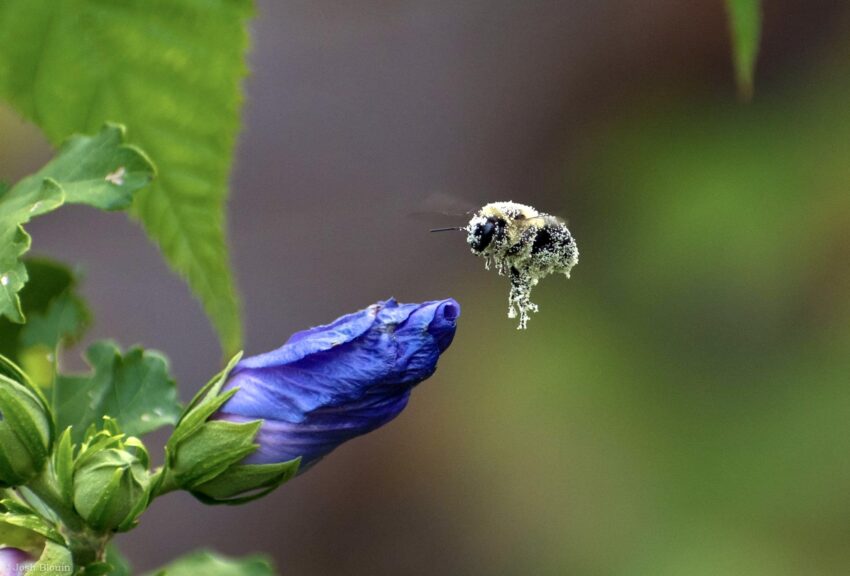As the last vestiges of snow snake between rocks, trying to hide from the warming sun in cool crevices, it feels as if we have the luxury of time before spring is truly upon us. However, there is that one week, usually in April when the temperature rises and the snow finds there is no longer anywhere to hide. The streams explode down the mountainside, the peepers call to their lovers in the evening light and it is time to paint hives.
Italian Honeybees are our new livestock. We have hammered together the parts for our two hives, built frames and carefully stacked them. I’m on my second reading of the Beekeepers handbook. Last week I headed for the hardware store to find low VOC paint. Apparently the lower the VOC, the higher the price. I decided on Basil Green. Both because it feels that color will make the hives blend more into their surroundings and Basil is my father’s name. I leave the store, stir sticks and sponge brushes tucked under my arms, feeling satisfied that I am doing something proactive.
Being outside in early spring weather is a little like being at the airport for me. The moment I enter, I begin to run. There is the ever-present sensation of having to rush, whether it is real or not. Receiving an email telling us that our two packages of bees totaling over 6000 bees would be arriving on May 7 is that push. The realization that no-hive no-home is a big one.
Normally on the weekends we spend Saturday afternoon hiking or doing something enjoyable together. For this weekend, we compiled long lists of tasks to accomplish, and struck out, list in hand, Saturday morning. As a nod to the “fun” part of the weekend, we did hit our favorite bakery for croissants and tea, but as soon as we were done and had pushed the tons of crumbs from our laps, off we went.
As usual we had at least one dog in the back seat of the truck and as the trip progressed, Muir became surrounded by bags of sheep minerals, cinder blogs and wool blankets back from the dry cleaners.
Once home, Paul loaded up the wagon with the blocks which would be used as a foundation to place the hives on. He’d have to level the land first so a shovel rode along. I was set up in the garage with stacks of hive parts, supers and tops. Nothing interior that will come in contact with the bees can be painted so I have to be careful with my little tapered brushes.
I quickly remember why I’ve been awarded world’s worst painter several years running. Basil Green begins to dribble down both the edge of the can and my arm. I use all of my painter’s moves; the swipe, the dab, the dash. Nothing improves it.
After several hours I’m finished and I have a leaning towers of green bee hive components in front of me. Paul comes up and, based on the amount of paint on me and the look in my eye, he nods his approval without comment.
I gather and lather to no avail. Making a quick trip to the grocery store, I am steering with Basil Green arms.
As requested, before the bees arrive, we take stock of our bee equipment, checking off the parts of the hives we’ve assembled, two feeder jars, sixteen racks waiting for warmer weather to put wax sheets into so the wax won’t crack, a smoker and my full suit to include hat and head net.
It seemed important to have an extra head net and jacket, at least, so that I could have an extra set of hands in the hive if (when) needed. In other word’s, Paul’s suit.
Finding that another new suit would cost us about $200, I placed a note in Front Porch Forum to see if anybody might have some extra, not-terribly-used bee stuff lying about.
That afternoon, after brushes were cleaned and the soft spring air was drying the hives, a black Toyota truck drove into our driveway. A man stepped out and waved hello. He reminded us that he had, at one point, brought a violin to the shop for some work. He came bearing a bee hive top of hat and head net. His parents had kept bees most of his growing up life and were now downsizing their equipment, saw my request and wanted to re-home the suit. No cost.
I gratefully took it in my hands and we began talking about what we were doing, how inadequate I was feeling and his history with bees. We laughed as he told stories of being stung then learning to tuck his pant legs into his socks and rubber band them tightly shut. He talked about his fascination with bees and the beauty of their work.
Sunday morning we made a run to the farm store for fencing supplies. Mike asked us what we were fencing and when we told him he was excited for us and said that he, too, had kept bees growing up, first under the tutelage of his grandfather and then his father. He said they were the most fascinating creatures to watch work and he missed keeping them. He offered to come see our hives any time which planted a tiny seed of security in me.
This afternoon we will open the book and figure out how to put the hives together properly. Before long we will have Basil Green stacks of bee hives resting under our pear and cherry trees. We will welcome the honey but it is, once again, the cross communication between species that fascinates us. The idea that doing this is much bigger than ourselves.
It seems we are pollinating a new community.
